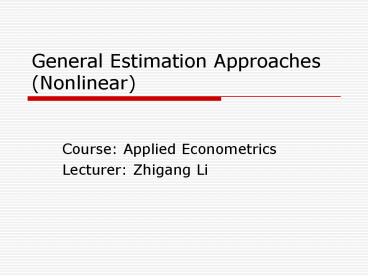General Estimation Approaches Nonlinear - PowerPoint PPT Presentation
1 / 14
Title:
General Estimation Approaches Nonlinear
Description:
Our purpose is to obtain good estimates of some parameters. ... OLS mainly, but there are many occasions (mostly nonlinear models) in which have ... – PowerPoint PPT presentation
Number of Views:59
Avg rating:3.0/5.0
Title: General Estimation Approaches Nonlinear
1
General Estimation Approaches(Nonlinear)
- Course Applied Econometrics
- Lecturer Zhigang Li
2
Purpose
- Our purpose is to obtain good estimates of some
parameters. There are generally many different
ways of achieving this. We have been using OLS
mainly, but there are many occasions (mostly
nonlinear models) in which have better
alternatives. - Generalized Method of Moments (GMM)
- Maximum likelihood Estimators
3
Method of Moments
- The idea of the Method of Moments estimators is
to find parameter estimates that let the actual
moments and model-based moments match the best. - Moments Mean, variance, correlation,
- Actual moments are typically functions of actual
data and the chosen parameter estimates.
4
Example 1
- E(Y)µ
- Y is actual data
- µ is the parameter to be estimated
- Rewrite the equation as E(Y-µ)0
- Actual Moments S(Y-µ)/n
- Model-based moment 0
- We try to find a value for µ such that
- S(Y-µ)/n0
5
Example 2
- IV Estimation
- The model is f(Y, X, ?)e
- The function f(.) could be nonlinear in ?. The
linear model Y ?Xe is a special case. - X could be endogneous.
- Suppose that an instrumental variable Z is
available (if X is exogenous, then Z can be X
itself). - What is the moment condition we could use?
- EZf(Y, X, ?)0
6
Example 3
- Intertemporal Optimization
- Eßu(ct1)(1rt)-u(ct)Ot0
- Where Ot indicates the information set available
at time t. - This suggests that any variables zt in the
information set Ot can be an instrument because - Eztßu(ct1)(1rt)-u(ct)0
7
Generalized Method of Moments (GMM)
- In MM, the number of moment equations is the same
as the number of parameters to be estimated (this
is called exactly identified). - In GMM, the number of moment equations is more
than the number of parameters to be estimated
(this is called over-identified). In this case,
parameters satisfying all the moment equations
may not be available. - Solution Instead of solving the equation system
for parameter estimates, we search for parameter
values that can minimize some reasonable
criterion function. - For example, in example 2, if we have only one
parameter ? to estimate but we have n
instrumental variables, then we can minimize - SEZif(Y, X, ?)2
8
GMM Framework
- Moment Conditions
- Eml(y,x,z,?)0, l1,2,,L.
- GMM
- Search for values of ? to minimize
- Where A is a positive definite matrix to produce
a consistent estimator of ? and m-bar is the
sample average of the moment equations
9
Key Assumptions of GMM
- Y, X, and Z are stationary.
10
Maximum Likelihood
- Idea Choose parameter values such that the
theoretical likelihood for the observed data to
happen is the largest.
11
A Simple Example
- For example, suppose we have a couple of
observations of a variable X with normal
distribution N(µ,1). What is a good estimate of
µ? - Least Square Choose µ to minimize S(xi-µ)2.
- Maximum Likelihood Assume that the observations
are independent, then the likelihood of observing
all of them is the product of the density of them
each f(x1µ)f(x2µ) f(xnµ), where
f(xiµ)exp-(xi-µ)2/(2p)1/2. Therefore, we may
choose µ to minimize - -Slogf(xiµ)
12
Example 2 Estimating Autoregressive Model
- xt?xt-1ut
- f(x1, x2,, xn)g(xTxT-1)g(x2x1)g(x1)
- Where f(x1, x2,, xn) is the density of observing
the actual time series x1, x2,, xn. - Assume the variance of ut is one and the
distribution is normal, then g(xtxt-1)
exp-(xt-?xt-1)2/2 /(2p)1/2 - We can estimate the value of ? by minimizing
logf(x1, x2,, xn).
13
Example 3 Binary Response Models
- P(y1X)G(ßX)
- Y is either 0 or 1.
- P(y1X) is the probability for y to be one given
the actual value of X. - For example, y may be whether to get higher
education and X may be the characteristics of an
individual and his/her family. - Compared with the linear probability model we
have discussed before, the binary response model
does not predict probabilities greater than one
or less than zero. - In the logic model, G is the logistic function
G(z)exp(z)/1exp(z)
14
How to estimate the binary response models?
- Assume that we have a random sample of size n
(i.e. we have n observations each of them
contains information on binary variable y and
usual variables X). - Similar to example one, since we have random
sample, the density of observing y1, y2, , yn is
simply the product of the density of each of the
ys. - f(yiXi)G(ßXi)y1-G(ßXi)1-y, y0,1.































